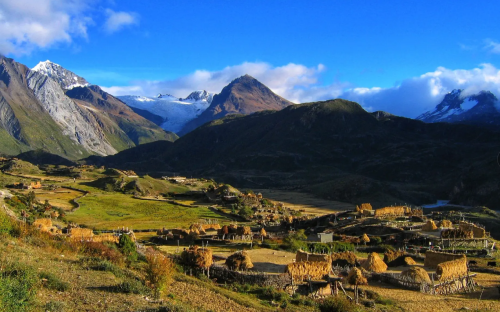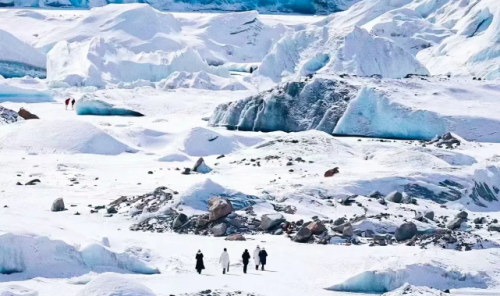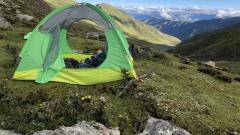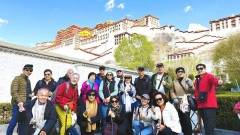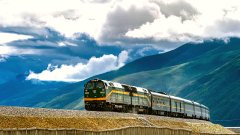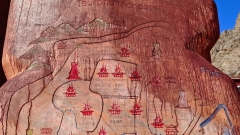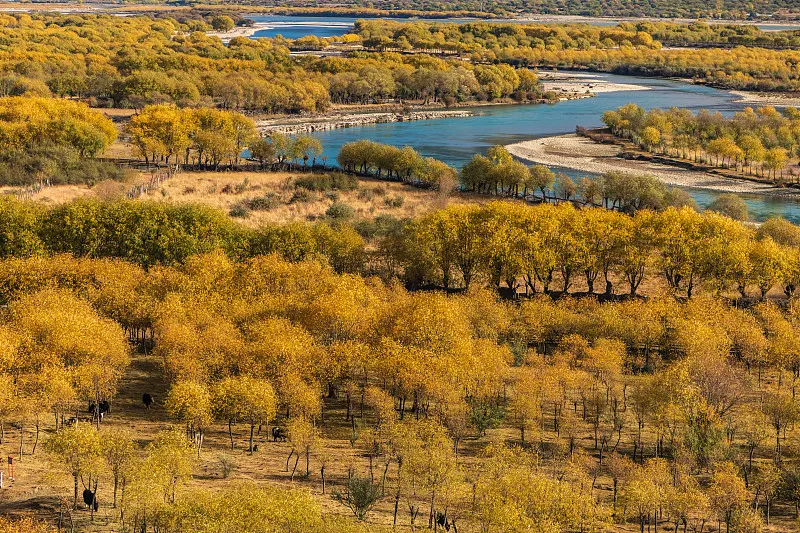Ranwu Lake: The Sapphire of Eastern Tibet
Situated along National Highway G318, Ranwu Lake (然乌湖) is often called the most beautiful lake in Tibet — and for good reason. Stretching over 20 kilometers, the lake sits at an elevation of 3,850 meters, reflecting snow peaks, pine forests, and grazing yaks in its crystal-clear waters.
Best Viewpoints:
-
Upper Ranwu Lake: The eastern side offers wide panoramas of the Gangrigabu Mountain Range and brilliant blue waters under an open sky.
-
Lower Ranwu Lake: The western side features dense forests and small villages, especially stunning in autumn when the trees turn golden.
-
Sunrise and Sunset: Mornings bring misty reflections, while evenings glow pink and gold against the snowy peaks — perfect for photographers.
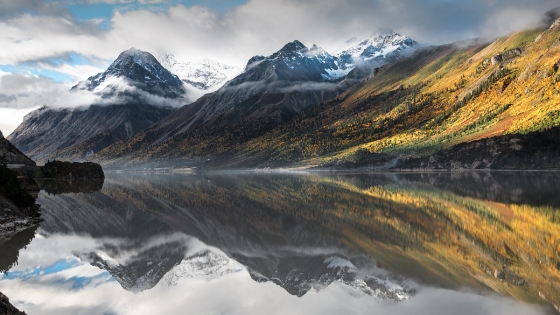
Travel Tip: The best months to visit Ranwu Lake are April to June and September to November, when skies are clear and roads are open.
Laigu Glacier: Where Ice Meets Heaven
A short 20 km drive from Ranwu, Laigu Glacier (来古冰川) is one of the largest and most accessible glacier clusters in China. It includes six major glaciers, including the famous Ruojiao Glacier and Dongga Glacier, all cascading from the Kawagebo Range into the valley below.
Highlights:
-
Glacier Village (Laigu Village): Nestled at the foot of the ice, this small Tibetan settlement offers an unbeatable view of multiple glaciers in one panorama.
-
Ruojiao Glacier: Known for its blue ice walls and shimmering patterns, it’s one of the most photogenic glaciers in Tibet.
-
Glacier Hiking: Short walks around the lake or towards the ice tongue are possible for most visitors. Experienced trekkers can arrange longer hikes with local guides.
Local Insight: In winter (November–March), Laigu Glacier is breathtakingly clear under bright sunlight, and the surrounding lakes freeze into surreal crystal patterns — ideal for landscape photography.
Hidden Villages Around Ranwu and Laigu
Beyond the famous lake and glacier, this region hides several ancient Tibetan villages untouched by modern tourism. Exploring them reveals the authentic lifestyle and spiritual tranquility of eastern Tibet.
Laigu Village:
-
Located beside Laigu Glacier, it’s one of Tibet’s most photogenic hamlets. Wooden houses with prayer flags face the shimmering ice. Locals often invite travelers to taste yak butter tea or tsampa.
-
At sunrise, the entire valley glows golden, and the glacier reflects the first light — a truly unforgettable moment.
Dongga Village:
-
A small farming community surrounded by barley fields and streams. Ideal for short walks and cultural photography.
-
Visitors can sometimes see villagers chanting prayers or weaving carpets by hand.
Basu (Baxoi) Town:
-
About 40 km west of Ranwu Lake, Basu serves as a convenient stopover with guesthouses, local restaurants, and fuel. It’s also a gateway to Lhoka and Nyingchi if you continue westward along G318.
Cultural Tip: Always greet locals with a smile and a slight nod. Offering small gifts like fruit or postcards from your home country is appreciated — but never take photos without permission.
Road Trip Experience: G318 from Nyingchi to Ranwu
Driving along China National Highway 318 (G318) — known as the “Sky Road of Tibet” — from Nyingchi to Ranwu is one of the most scenic routes in Asia.
Route Highlights:
-
Bomi County: Lush forests, waterfalls, and the snow peak of Namcha Barwa (7,782 m).
-
Midui Glacier: Another must-stop glacier with turquoise meltwater lakes and easy hiking trails.

Midui Glacier
-
Tongmai Bridge: A thrilling drive through the once-dangerous Tongmai Highway section, now replaced with safe tunnels and bridges offering breathtaking views.
Distance: Nyingchi → Bomi (230 km) → Ranwu (130 km) → Laigu (20 km)
Travel Time: 2–3 days with scenic stops
Tip: The road is mostly paved but can be icy in winter. Hiring a local driver familiar with the terrain is recommended.
When to Visit Eastern Tibet
| Season | Temperature Range | Highlights | Notes |
|---|---|---|---|
| Spring (Apr–Jun) | 0°C–15°C | Melting glaciers, wildflowers, clear reflections | Great for photography |
| Summer (Jul–Aug) | 8°C–20°C | Lush green valleys, occasional rain | Avoid landslide zones |
| Autumn (Sep–Oct) | -5°C–15°C | Golden forests, mirror-like lakes | Best season overall |
| Winter (Nov–Mar) | -20°C–10°C | Frozen lakes, pure sunlight, fewer tourists | Cold but photogenic |
Travel Essentials & Tips
Getting There:
-
By Air: Fly to Nyingchi Mainling Airport or Qamdo Bangda Airport, then drive to Ranwu (5–8 hours).
-
By Land: Overland travelers can start from Lhasa and follow G318 eastward for about 1,000 km to reach Ranwu.
Accommodation:
-
Ranwu Lake: Several small guesthouses and lakeside lodges with panoramic views.
-
Laigu Village: A few homestays available — basic but cozy, with unbeatable glacier views.
Permits:
Foreign travelers must obtain a Tibet Travel Permit, usually arranged by a licensed travel agency like China Dragon Travel.
What to Pack:
-
Warm layers, sunscreen, and lip balm (UV radiation is strong).
-
Camera, extra batteries, and filters for glacier light conditions.
-
Snacks and bottled water for long drives between towns.
Why Visit This Hidden Region?
While places like Lhasa and Everest Base Camp attract thousands of tourists each year, Ranwu and Laigu remain Tibet’s quiet masterpiece — a landscape of reflection, purity, and peace.
Here, travelers can:
-
Watch glaciers descend into turquoise lakes.
-
Stay with villagers whose lives still follow ancient rhythms.
-
Drive through valleys that look untouched by time.
It’s a journey for the soul — one that reminds us how vast, fragile, and beautiful the Earth can be.
Conclusion
Exploring beyond Laigu Glacier to Ranwu Lake and its hidden villages offers an unforgettable experience of Tibet’s raw beauty and timeless serenity. Whether you come for photography, adventure, or quiet reflection, this region rewards every traveler with moments of wonder that words can barely capture.
For guided tours, photography expeditions, and overland travel permits, visit China Dragon Travel — your expert in authentic Tibet experiences.



